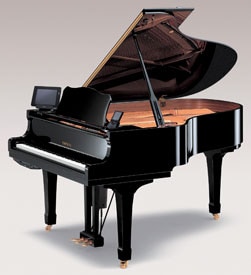Happy 20th Birthday, Yamaha Disklavier!
 Yamaha Disklavier Mark IV |
"The Disklavier's cutting-edge technology, acoustical authenticity, ease-of-use and reliability were once nearly inconceivable," says Bill Brandom, Disklavier Piano Marketing Manager. "This truly remarkable instrument consistently reveals Yamaha Corporation of America's innovative approach to music-making, as well as its dedication to staying well ahead of the curve."
A brief timeline of technological advances reveals the Disklavier's rise to market prominence as an easy-to-use, yet astonishingly interactive, instrument that can reproduce "live" acoustic piano concerts and ensemble music with full instrumental backings and vocal tracks.
- December 1987 – The first Disklavier, the MX100A, with record and playback capabilities, is introduced in the U.S.
- March 1988 – First consumer purchase of a Disklavier upright piano
- July 1989 – First Disklavier grand piano, with incremental pedaling and self-calibrating capability
- September 1992 – The MX1000II/DGPII is released with ensemble record capability
- February 1996 – The MX100IIXG/DGPIIXG is released, featuring 2HD, SMF and Flash Memory
- July 1997 – The DGTIIXG GranTouch with Disklavier system arrives. This was the first digital piano, equipped with an acoustic grand action and installed Disklavier system.
- March 1998 – The DKVPRO, a high-end Disklavier with Servo Control Solenoids suitable for studios, institutions and other advanced recording and professional music production needs, is released
- April 1998 – The DGPS Disklavier Grand is released, the first featuring Silent Function
- October 1998 – The first Playback Only Disklavier Grand piano arrives
- January 2000 – The PRO2000 arrives
- April 2000 – The Disklavier Mark III is released, featuring expanded memory and newly added CD function
- November 2000 – World premiere of George Antheil's Ballet Mécanique in its original instrumentation from 1926, performed by 16 Disklavier pianos
- 2000-2001 – Two Disklaviers (1988 upright piano and PRO2000) are displayed during PIANO 300: Celebrating Three Centuries of People and Pianos exhibit at The Smithsonian Institute, and video of the Disklavier PRO2000 in action is featured during PBS broadcast of People and Pianos: 300 Years
- 2001 – Disklavier wins Music Merchandise Review's "Product of the Year Award," beginning an unprecedented six-year winning streak
- June 2002 – The first International Piano-e-Competition is held using Disklavier pianos in St. Paul, Minnesota and Japan
- Spring 2003 – Medical researcher Dr. Kathleen Riley uses Yamaha's V-Sync technology for the Disklavier to diagnose and test pianists for focal dystonia
- April 2004 – The Disklavier Mark IV is unveiled
- 2005 – Release of Nude Rolling Down An Escalator: Studies for Disklavier by Kyle Gann, the first CD composed and performed entirely on a Disklavier
- 2005 – Introduction of the Elton John Signature Series Red Piano, a special edition series of 30 "Chinese Red" Mark IVs featuring five actual Elton John performances recorded specifically for the Series and unavailable anywhere else
- September 2006 – First commercial CD recording using the technology of Zenph Studios and Disklavier Pro to capture the original performance intentions of Glenn Gould's legendary 1955 rendition of Bach's Goldberg Variations
- 2006-2007 – Demonstrations of the Disklavier's Internet-based educational application, "Remote Lesson," at several locations
- April 2007 – Disklavier version 2.0 launched, featuring DisklavierRadio and DisklavierMusicStore, marking the first time in history that an Internet-connected player piano streams live performances into the home, offering non-stop entertainment, 24/7. Users can either listen to live streams of a variety of musical genres or purchase music for download to enjoy whenever they wish.
And, the future of piano pedagogy has been forever changed, thanks to the Disklavier's virtual elimination of geographic barriers between pianist and educator. In 2006, Yamaha Corporation of America and the Yamaha Disklavier piano won the Music Teachers National Association's (MTNA) Frances Clark Keyboard Pedagogy Award, marking the first time a music product received the honor. According to Dr. Samuel Holland, executive director of the Frances Clark Piano Foundation, the award recognized the Disklavier as "a product whose influence on how music can be created and thereby taught is truly transformative – an influence so potentially great that we are still only beginning to glimpse the possibilities."
For more information, write Yamaha Corporation of America, Piano Division, P.O. Box 6600, Buena Park, CA 90622; telephone (714) 522-9011; or e-mail infostation@yamaha.com.
